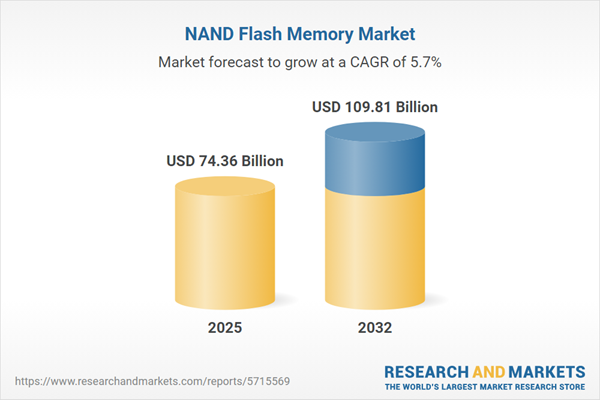Speak directly to the analyst to clarify any post sales queries you may have.
The NAND flash memory market is evolving rapidly as organizations confront changing storage demands and heightened supply-chain complexity. For senior decision-makers, the landscape requires responsive strategies to balance innovation, scalability, and regulatory adaptation.
Market Snapshot: NAND Flash Memory Market Size and Growth
The NAND flash memory market expanded from USD 70.32 billion in 2024 to USD 74.36 billion in 2025, with projections reaching USD 109.81 billion by 2032—demonstrating a 5.72% CAGR.
Growth is powered by breakthroughs in memory layer density, maturation of interface standards, and diverse application cases across automotive, enterprise IT, and additional sectors. This trajectory underscores the market’s foundational role in supporting the next generation of global storage infrastructure through advanced, adaptable solutions.NAND Flash Memory Market Scope & Segmentation
- Memory Types: Multi-level cell (MLC), quad-level cell (QLC), single-level cell (SLC), and triple-level cell (TLC) memory options enable organizations to align endurance, capacity, and cost according to unique commercial and enterprise needs.
- Architectures: Both 2D planar and 3D vertical stacking architectures are designed to optimize data density and reliability for a variety of real-world workloads, enhancing operational flexibility.
- Interfaces: Leading formats such as NVMe, PCIe Gen 3/4/5, SATA, and USB offer a spectrum of performance levels, supporting deployments from low-latency data centers to cost-efficient environments.
- Form Factors: Storage is available in eMMC, microSD, internal and external SSDs, UFS, and USB drive formats, addressing embedded, modular, and portable requirements across industries.
- Applications: High-performance solutions serve automotive electronics, consumer electronics, smartphones, and enterprise storage, each with specific priorities regarding speed and data reliability.
- End Users: The sector meets the requirements of organizations across automotive, industrial, IT and telecom, and consumer electronics fields, reflecting expanding usage in both edge and core infrastructure settings.
- Capacity Tiers: Configurations range from compact options under 128 GB to large-capacity solutions above 1 TB, facilitating scalability from mobile devices to enterprise storage systems.
- Distribution Channels: Direct sales, authorized distributors, OEM agreements, and online retail make products accessible for diverse deployment and procurement needs, in line with evolving purchasing habits.
- Geographies: The market operates globally across the Americas, EMEA, and Asia-Pacific regions, with leadership and innovation driven by key markets such as the United States, China, Germany, Japan, and South Korea.
- Key Companies: Industry direction is shaped by entities including Samsung Electronics, Kioxia Holdings, Western Digital, SK hynix, Micron Technology, Intel, and Yangtze Memory Technologies, each advancing solution development and influencing strategic trends.
Key Takeaways: Strategic Insights for Decision Makers
- Vertical stacking and advanced cell architectures are increasing storage density and energy efficiency, supporting intricate sectoral demands and modern workflows.
- Widespread adoption of PCIe-based NVMe interfaces is driving lower latency and broader system compatibility, which is vital for high-volume enterprise and data center platforms.
- Ongoing innovation in controller and form factor design supports durability and tailored solutions, especially for automotive safety systems, smart appliances, and edge deployments.
- Effective collaboration with OEMs and ecosystem partners is essential for co-developing robust, flexible solutions that fulfill operational and regulatory benchmarks.
- Firms that focus on regional supply chain agility and sustainable manufacturing can better manage regulatory fluctuations and mitigate the impact of market volatility.
Tariff Impact: Navigating Regulatory Change in 2025
U.S. tariffs affecting semiconductor imports in 2025 are prompting shifts in cost management and procurement strategies within the NAND flash memory sector. Vendors are investing in regional manufacturing and alternative sourcing models, while enterprises and OEMs are refining their supply chain strategies for continuity and risk mitigation. Adaptable organizations with diversified supplier bases are positioned to respond proactively to ongoing regulatory changes.
Methodology & Data Sources
Research methodology incorporates executive-level interviews, proprietary shipment datasets, and in-depth reviews of industry literature and patent activity. Quantitative modeling and analyst validation ensure actionable and relevant insights for technology leadership.
Why This Report Matters
- Equips leadership with planning guidance aligned to evolving technology, use cases, and shifting regional dynamics in the NAND flash memory market.
- Supports proactive adaptation of procurement strategies and supply chains in response to new regulatory conditions.
- Offers clear segmentation and geographic context to inform buying, R&D, and international market development initiatives.
Conclusion
Ongoing advancements and regulatory dynamics continue to reshape the NAND flash memory sector. Access to robust, current intelligence enables decision-makers to fine-tune strategies and realize new opportunities in the global storage domain.
Additional Product Information:
- Purchase of this report includes 1 year online access with quarterly updates.
- This report can be updated on request. Please contact our Customer Experience team using the Ask a Question widget on our website.
Table of Contents
3. Executive Summary
4. Market Overview
7. Cumulative Impact of Artificial Intelligence 2025
List of Figures
Samples

LOADING...
Companies Mentioned
The key companies profiled in this NAND Flash Memory market report include:- Samsung Electronics Co., Ltd
- Kioxia Holdings Corporation
- Western Digital Corporation
- SK hynix Inc.
- Micron Technology, Inc.
- Intel Corporation
- Yangtze Memory Technologies Co., Ltd
Table Information
| Report Attribute | Details |
|---|---|
| No. of Pages | 186 |
| Published | October 2025 |
| Forecast Period | 2025 - 2032 |
| Estimated Market Value ( USD | $ 74.36 Billion |
| Forecasted Market Value ( USD | $ 109.81 Billion |
| Compound Annual Growth Rate | 5.7% |
| Regions Covered | Global |
| No. of Companies Mentioned | 8 |









